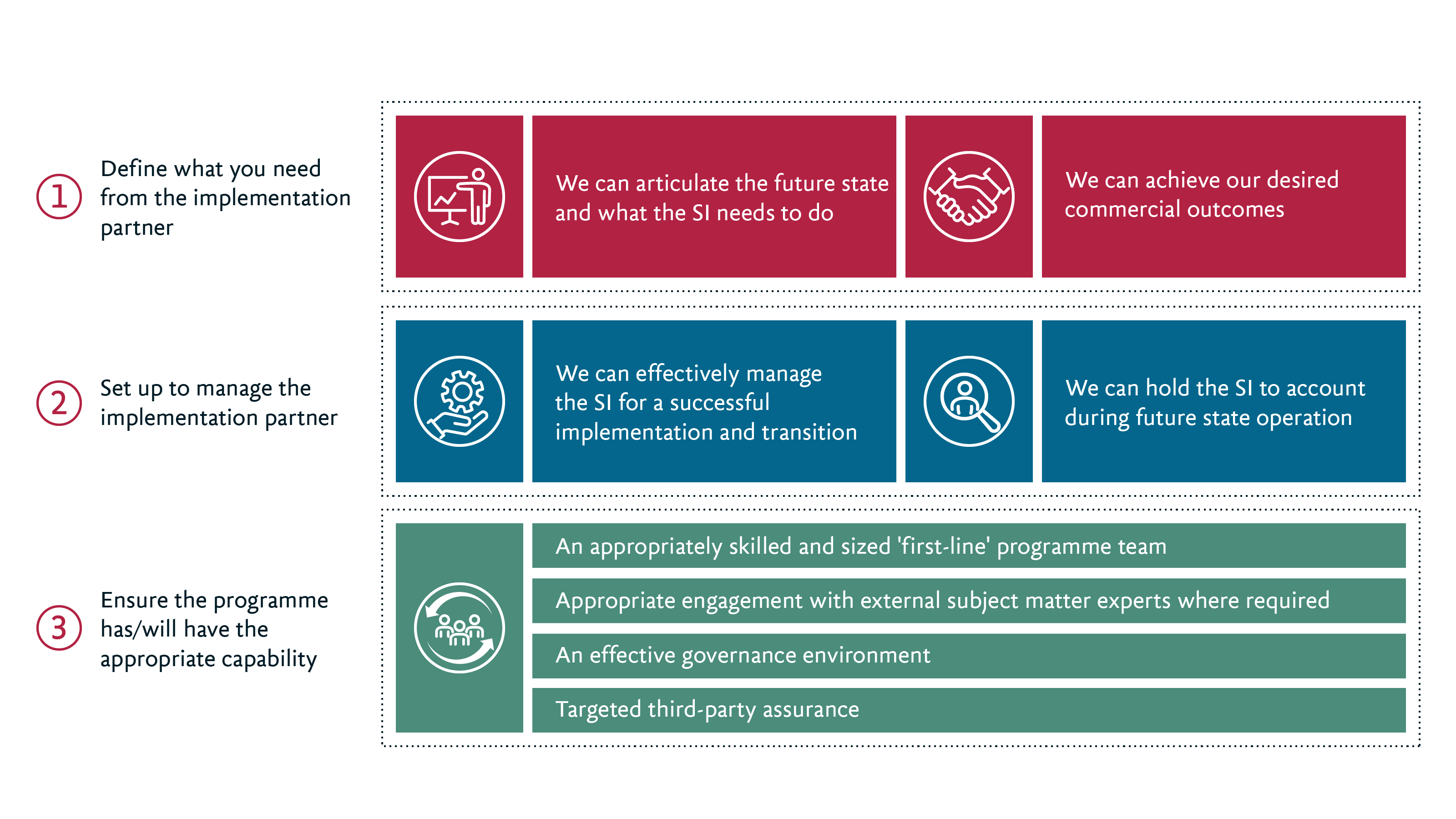No matter your S/4HANA migration approach, the implementation programme will always present a complex challenge. Selecting the right system integration (SI) partner, and establishing the right ways of working, will help to minimise the risk of things going wrong and help resolve things if they do.
What is an SI partner?
An SI partner is an organisation that can take responsibility for the delivery of technology-enabled business transformation. Their typical role on an S/4HANA migration programme could include:
- Leading and/or supporting the delivery of a project or programme, often taking overall accountability for their outcomes
- Providing an appropriately skilled and sized implementation team
- Engaging with third party subject matter experts where required
- Reducing overall risk by using best-of-breed and tried and tested approaches and methodologies.
It’s important to note that SI partners are not:
- Resource augmentation, for either business or technical needs.
- A development shop, providing highly specialised technical input for specific solution components.
How to be an ‘intelligent buyer’
Preparing for S/4HANA SI selection requires becoming an ‘intelligent buyer’. Throughout the selection process, you need to be clear about what you want, set yourself up to manage effectively, and ensure the programme has the right capability available.
Defining what you need from an SI
To get the best from an SI during an S/4HANA migration, you need to be sure about what you need from them. Establishing a successful partnership with an SI requires clearly articulating the future state, across technology, process and people. Then, you need to scope out the implementation services needed from the SI to deliver this vision.
Client organisations also need to think in terms of their contractual arrangements and decide what sort of guardrails they’re prepared to put in place to ensure commercial outcomes are achieved. This will require balancing risk with reward. For example, the buyer could opt for a fixed price contract to mitigate the risk of spiralling costs but this increases the risk of the SI seeking to wrap up the programme as quickly as possible, potentially at the risk of overall quality. An intelligent buyer will consider their organisation’s appetite for risk carefully and identify the right set of trade-offs.
Another critical factor for determining your needs is the ability to look inward: start by assessing your own organisational make-up and culture, which will impact the SI relationship. Does the organisation prefer agile to waterfall delivery? What skills and experience does the internal programme team already bring? Is on-shore or offshore delivery preferred, or a blend of both? These are the types of issues that the intelligent buyer should define before contracting with an SI.
How to manage your implementation partner
An intelligent buyer is already thinking about effective SI management from the outset. Even during the SI selection process, the client organisation should be considering ways of working and how to maintain accountability throughout the S/4HANA migration, transition and post-go-live.
Sophisticated clients understand that success is heavily dependent on building a trusted relationship. The client needs to be able to give the SI an appropriate level of autonomy – and corresponding accountability – while retaining the ability to intervene if and when needed.
This links back to contractual and commercial arrangements. While you don’t necessarily want to manage-by-contract, you do need to be able to pull the right levers throughout the S/4HANA journey. This could include appropriate incentives, such as milestone or outcomes-based payments, or the offer of longer-term agreements such as support contracts.
A good working relationship ultimately rests on the people involved. From the very top of the chain down through the programme structure, the intelligent buyer considers who is responsible for which part of the scope. Crucially, this includes matching up the right senior executives on both sides so that any escalation can be handled effectively.
Some organisations go as far as putting in place a layer of management over and above the programme, specifically for supplier relationships. Their remit includes a regular macro-level assessment of the qualitative and quantitative measures of the health of the relationship. This will not be the right mechanism for every organisation, but some will find it worth considering.
Ensuring your programme has appropriate capability
Similarly, your programme capability will have a large impact on how you work effectively with an SI and so you need to consider these issues up front. This includes factors such as:
- The size and skill of your programme team
- Whether you need external subject matter experts and how you will engage with them, including your relevant technology providers
- Effective programme governance
- Third-party programme assurance.
Often, client organisations overlook the need for internal training on solutions. An appropriate level of internal knowledge will better enable peer-like relationships with the SI experts, and the ability to understand and manage the new solution over the long term.
This is equally true for awareness and understanding of current business processes, which shouldn’t be the exclusive domain of subject matter experts or end users if an S/4HANA programme to be successful. To provide the SI with necessary business knowledge, the client-side programme team needs to know precisely why things are done at present. This enables better decision-making, whether that is to retain existing ways of working or to encourage open-mindedness over potential improvements.
Building the right internal programme team will always require a degree of committed resource. The most successful S/4HANA programmes will draw the best people from across the business to dedicate themselves to the project. Too often, clients under-call this and expect the SI to pick up the slack when they could have considered a more optimal balance.
The intelligent buyer ensures the business case addresses the backfilling of roles and aims to secure necessary commitment from the senior sponsor.
Setting yourself up for success with an SI partner
Choosing the right SI partner for an S/4HANA migration requires careful consideration of the programme objectives, governance and capability. It may sound obvious but surprisingly, many organisations fail to examine these key details prior to selecting their SI.
Adopting an ‘intelligent buyer’ framework will help prevent this common mistake. Client organisations need to think through their needs across the implementation lifecycle, which includes defining a clear ambition and target end state, assessing internal culture and skills, and setting up the right governance and accountability mechanisms.
These factors will help the client to find the right SI and establish the right contractual terms and also build a successful partnership throughout the programme. This not only ensures you reach the desired benefits from S/4HANA but perhaps almost as importantly, enables a much smoother journey to getting there.











